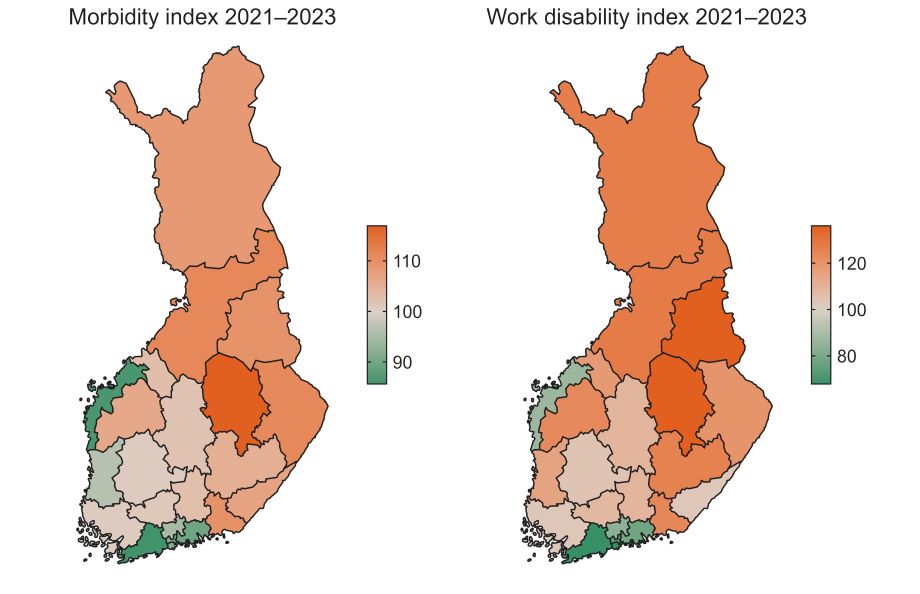National Health Index 2021–2023
Morbidity and work disability are still most prevalent in Eastern and Northern Finland
The National Health Index describes regional differences in morbidity and work disability of the population in Finland (Figure 1). Regional differences can also be examined separately for men and women.
The morbidity index is the highest for men and women in North Savo. North Ostrobothnia, North Karelia and Kymenlaakso are also regions with high morbidity rates for both men and women. The differences between regions are largest in alcohol-related diseases compared to other disease groups.
The work disability index is highest for men in Kainuu and for women in North Savo. Regional differences in work disability are larger for favourable decisions on vocational rehabilitation applications than for work disability pensions and sickness allowances. For men, work disability pensions and sickness allowances are most often paid in Kainuu. For women, work disability pensions are most common in North Savo and sickness allowances in Lapland. Men and women are most likely to receive a favourable decision on vocational rehabilitation application in North Karelia.
Download the statistical report

The dataset of the National Health Index covers several indicators on the population’s morbidity and work disability. The index data are produced in cooperation between THL, the Social Insurance Institution of Finland (Kela), the Finnish Centre for Pensions and Statistics Finland.
The dataset includes both the morbidity index and its disease group-specific subindices and work disability index and its subindices.
The morbidity index contains 10 disease groups. Its subindices describe the prevalence of cancers, coronary disease, cerebrovascular diseases, musculoskeletal disorders, severe mental health disorders, accidents, memory disorders, respiratory diseases, diabetes and alcohol-related diseases. In the morbidity index, the prevalence of each disease group is weighted based on its burden in terms of mortality, work disability, impact on quality of life and the costs of health and social services.
The work disability index has three subindices: disability pension, sickness allowance and positive decisions on vocational rehabilitation.
Tables and images
- Indicator data in Sotkanet – morbidity index and disease group-specific subindices
- Indicator data on Kela’s Info Tray – work disability index and its subindices
- Statistics in pictures
Background information
- Quality report
- Disease groups and data sources of the subindices of the National Health Index
- Disease group-specific weighting factors in the National Health Index
- More about the development project
- Previous statistics 2020-2022 (Julkari)
Description of the statistic
The figures of the health index describe the health and work ability of the population of the wellbeing services counties and municipalities in relation to the entire country [entire country = 100). The more common morbidity or incapacity for work in the region, the greater the index value.
Both an age-standardised and a non-standardised version of the indices is produced. The age-standardised results level out the effects of age structures, so the results can be used in comparisons between regions. The non-standardised index in turn describes the actual burden of disease and work disability in the region.
In addition to the population's age structure, many factors contribute to the regional differences in morbidity and work disability. Lifestyle, such as smoking, alcohol use, physical activity, sleeping and eating habits have an impact, but lifestyle itself is affected by many things. Unemployment, financial situation and education are reflected in the population's health and work ability. The functioning of health and social services as well as cultural and genetic factors also play a role.
When comparing the index figures, it should be noted that a well-functioning healthcare system may be visible as a higher level of morbidity as diseases are screened, diagnosed and treated efficiently. Similarly, work disability is also affected by the availability of health services, which depends on the coverage and extent of occupational healthcare services, among other things. In the morbidity index, the regional differences may also be affected by differences in how comprehensively information is obtained from the regions (wellbeing services counties) and how it is transferred to THL’s Care Register for Health Care.
The dataset of the National Health Index is available from 2017 to 2023 to all wellbeing services counties, municipalities and collaborative areas of wellbeing services counties. The data will be updated on an annual basis.
Source
National Health Index 2021–2023
Statistical report 26/2025, 15 May 2025.
Finnish Institute for Health and Welfare (THL), Kela, Finnish Centre for Pensions, Statistics Finland
The name of the National Health Index in Finnish is "Kansallinen terveysindeksi" and in Swedish "Nationella hälsoindexet".
Further information
Suvi Parikka
tel. +358 29 524 7959
email: [email protected]
Elsi Lindell
tel. +358 29 524 7989
email: [email protected]
Kati Sarnola
tel. +358 20 635 7885
email [email protected]



